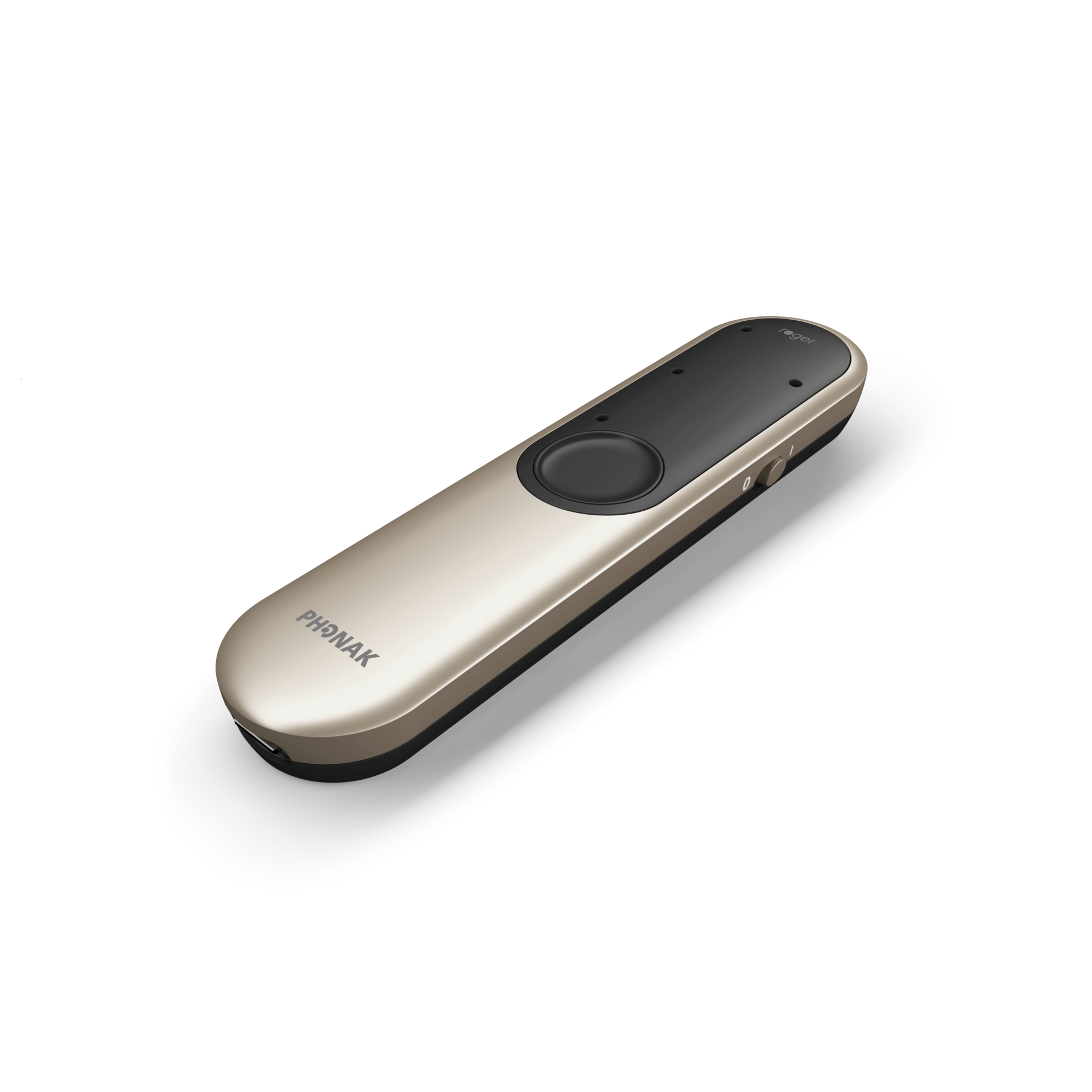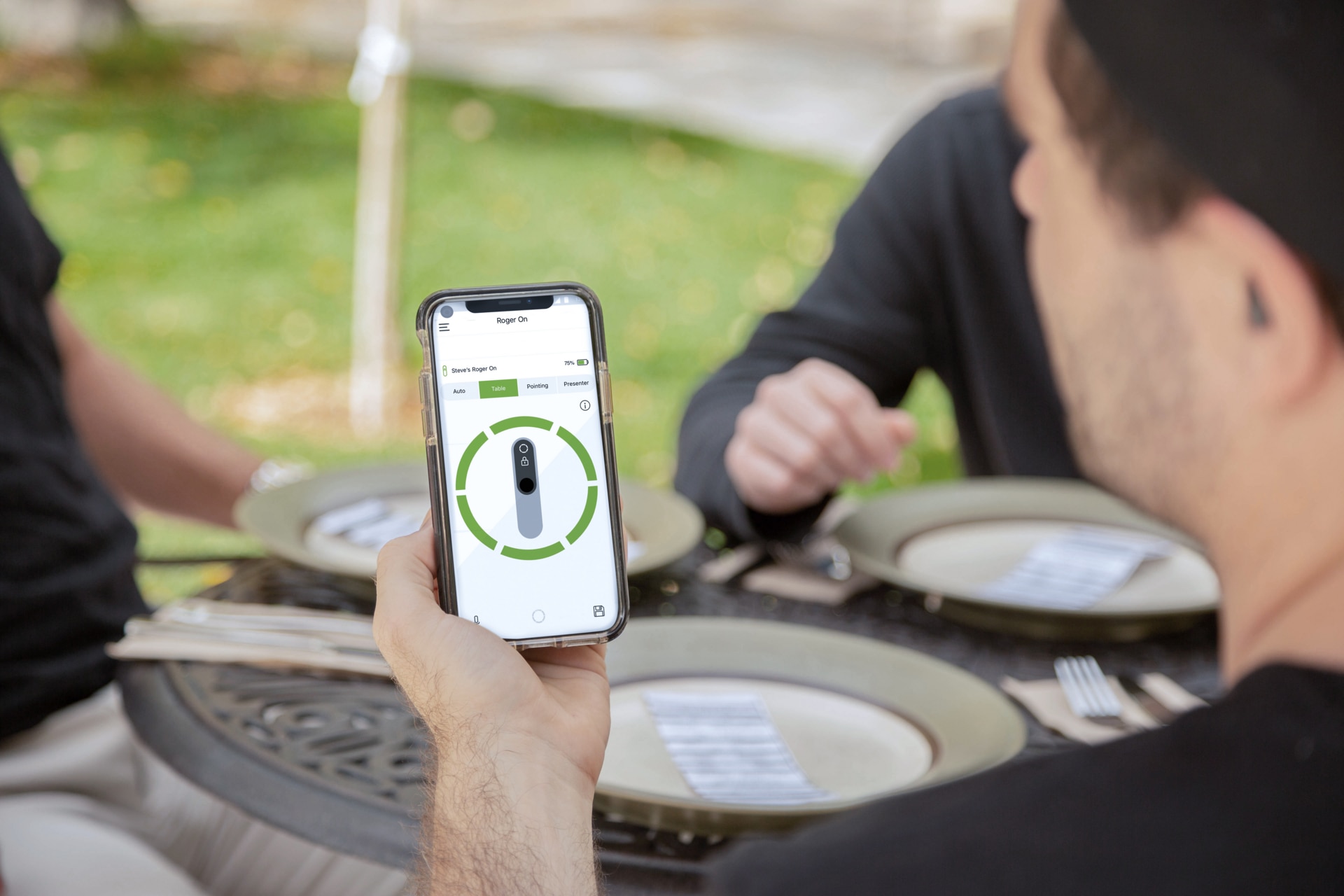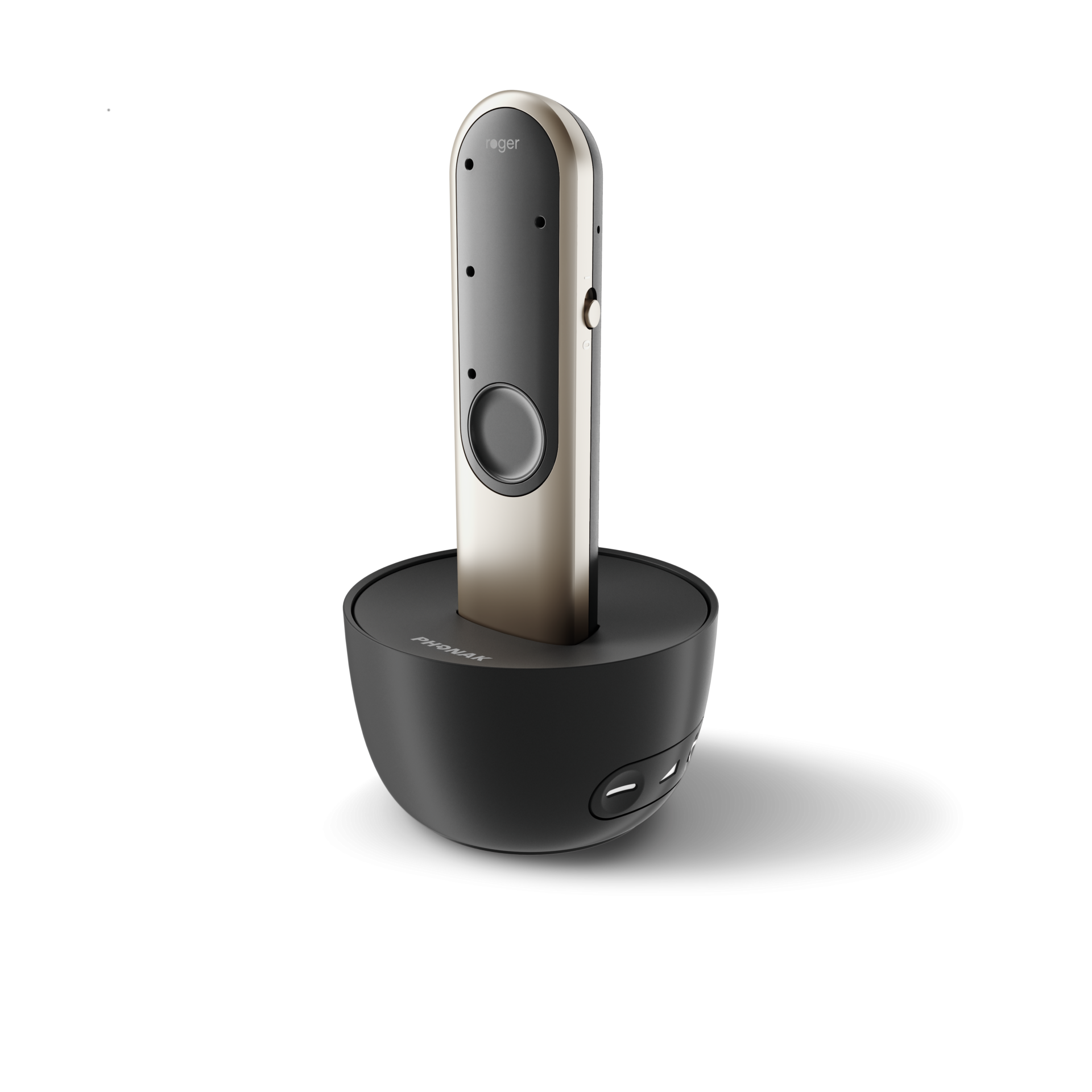Choose another country or region to see content specific to your location.

Phonak Roger On™
- Microphone
- speech in noise
- fully automatic
Roger On™ is a unique microphone for everyday use in noise and over distance. It recognizes if speech is coming from the left or right side of the wearer and provides spatial information to combine visual and audio cues.* It also helps support conversations by automatically selecting the person who is talking.
- Unlimited receivers built in **
- Can be used like a headset for online calls
- Automatically adapts to the listening situation
- Protected against splashes of water
- Scratch-resistant display for enduring elegance



Made for everyday listening
Roger On is an intelligent microphone for hearing aids designed for difficult and ever-changing listening situations in noise and over distance to help improve your quality of conversations.
Conversation support
Roger On helps improve the intelligibility of conversations when background noise is present with speech-in-noise performance,¹ while also identifying and automatically selecting the person speaking.
Online calls
With two-way audio streaming, both you and your online counterparts can hear clearly in noise while being heard above the noise.
Dining in restaurants
When in a restaurant environment, it usually includes a complex mix of sounds and background noise. With Roger On, distracting noises are reduced so you can capture the conversation.
Conversations in traffic
Engine sounds and road noise make conversations challenging. By transmitting the speaker’s words directly into your hearing aid, Roger technology helps overcome communication challenges.
Sports and recreation
Hearing coaches and teammates when playing sports can be a challenge. Roger On can identify who is speaking, and distracting noises are reduced so you can focus on the game. Being protected against splashes of water, it is suitable for all kind of sports and outdoor use.
Watch TV and more
Listen to the TV with a docking station that is provided with the Roger On or enjoy music by simply plugging the cable into a smart phone.
Scratch resistant for enduring elegance
No matter the lifestyle, Roger On is built to last and accompany any situation: whether it’s clipped onto a shirt, tucked into a pocket with keys, or placed in a backpack.
App remote control
With the myRogerMic app you can control your Roger On from your smartphone. It allows you to customize your microphone settings according to your environment and personal preferences. You can also steer the direction of the beam(s) towards the speaker or speakers you want to listen to, change the microphone mode, and more.
Long battery life
Be confident you won’t get caught without power with up to 8 hours of continuous use on a fully charged battery.
Before I had my hearing aids and the Roger On mic, my team boat partner had to relay messages from the coach to me. Now I hear my coach directly.



Versatile design
The flexibility of the Roger On microphone allows you to hold it in your hand, be placed on a table, worn by a speaker or stream online calls, depending on your needs. Your Roger On microphone settings will change automatically to suit your environment and offer the hearing performance you need
Headset mode
In online calls, your peers' conversation streams directly to your hearing aids, while your voice is sent to the computer, so they can hear you clearly above the noise. With this complete solution, your Roger On becomes your headset.
Table mode
In meetings or at a restaurant, the Roger On mic can be placed on the table and its MultiBeam 2.0 Technology helps you identify the source of the sound.*
Pointing mode
Pointing mode 2.0 uses three microphones in a row, allowing you to focus on the person talking, while ignoring side conversations when background noise is present.
Stereo wide pointing mode
Clever solution for low noise scenarios, where sharp directivity of Roger On is not required. Allowing more flexibility when listening to multiple speakers over distance and in the front.*** It also offers stereo transmission of the audio, giving you better localization cues. This new feature can be retro enabled on all Roger On microphones via the Roger Upgrader.
Presenter mode
In meetings or lectures, the presenter can wear Roger On as a clip-on lapel microphone and it will automatically pick up the voice of the speaker regardless of its position.
Streaming audio
Roger On can be connected to a laptop or TV’s audio output tp stream the audio directly to your hearing aids.
Connect multiple microphones
Roger On can be combined with other microphones, and it is recommended to use it with the Roger Table Mic II for the best listening experience.
SmartMute
When Roger On is muted, hearing aids with RogerDirect will instantly fall back to AutoSense OS™, keeping all the benefits of your hearing aids.****
Hear the difference
Experience the difference in speech understanding with and without Roger technology.

Connectivity and compatibility
Roger On is compatible with all Phonak hearing aids and almost any other hearing aids or cochlear implant brands via Roger receivers.
Roger Unlimited
All new generation of Roger microphones have unlimited receivers built in and ready to use with Phonak hearing aids integrating RogerDirect™.
Roger NeckLoop
Roger NeckLoop is a universal neck loop receiver compatible with any hearing aid or cochlear implant with a t-coil.
Roger X
Roger X is a miniature universal receiver that is compatible with virtually every hearing aid and cochlear implant speech processor on the market.
Roger design-integrated receivers
These receivers fit into the design of selected cochlear audio processors and are available in matching colors.
Roger On™
Frequently asked questions
- Roger On is highly versatile, with just one device you can cover almost all challenging listening situations.
- Roger On is high performing and uses four microphones to compute directional beams in multiple directions.
- Roger On automatically adapts to the listening situation and environmental noise, making it easy to use.
- Roger On is universally compatible with almost all hearing aids and cochlear implant sound processors on the market.
- Roger On comes with an app that lets you remotely control and customize the Roger On.
The third generation of Roger On comes with four latest updates:
- Unlimited receivers for easier set up of the Roger system by the hearing care professionals
- Stereo wide pointing mode – this is a new mode that allows a greater pick-up range compared to pointing mode. It can only be activated via the myRogerMic app
- SmartMute – this feature allows the hearing aid features to remain active in its base programme even when Roger On is on mute.
- Scratch resistant display, allowing greater resistance to scratches that may occur during daily use of the device.
The headset mode on the Roger On device is designed to work when connected via the USB cable to a USB port of a computer, tablet or smartphone. To utilize headset mode, simply connect your Roger On to your computer using the USB cable provided. For tablet and smartphone, a USB-C to USB-C cable might be required, such cables can be purchased at a low cost from electronic shops. Please note that headset mode is not supported when using the short audio cable connection.
Stereo MultiBeam (MultiBeam 2.0) and Stereo wide pointing mode requires a stereo stream and therefore left and right indication. Only RogerDirect knows to which side the hearing aids are fitted to. Other receivers do not have side indication and legacy MultiBeam / mono wide pointing mode will apply.
Roger On is protected against splashes of water but not waterproof. This means it can be used outdoors in the rain for example. When Roger On gets wet, switch it off and dry it with a dry cloth.
With the myRogerMic app you will be able to remotely:
- See the status of your Roger On (battery level, mic mode, etc.)
- Change the mic mode manually
- Steer the beam in a specific direction when Roger On is on the table
- Mute the microphone
Resources and downloads
Need product support?
Footnotes
The Bluetooth® word mark and logos are registered trademarks owned by Bluetooth SIG, Inc. and any use of such marks by Sonova AG is under license
* Works with hearing devices with RogerDirect™
**Available on the new generation of Roger On.
***Can only be activated via the myRogerMic App.
**** available through the Roger Upgrader
Thibodeau, L. (2014). Comparison of speech recognition with adaptive digital and FM wireless technology by listeners who use hearing aids. American Journal of Audiology, 23(2), 201-210

